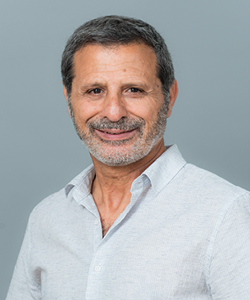מתעניינים בלימודים?
השאירו פרטים ונחזור אליכם בהקדם
טופס השארת פרטים פופאפ
"*" אינדוקטור שדות חובה
מתעניינים/ות בלימודים? השאירו פרטים ונחזור אליכם/ן
השאירו פרטים ונחזור אליכם בהקדם או חייגו כבר עכשיו 3622*
טופס השארת פרטים צף בהדר
"*" אינדוקטור שדות חובה
פרופ' פנחס דהן

השכלה
Associate Professor of Theoretical Physics
Completed B.A., M.A. & Ph.D. at Tel – Aviv University ,Department of Condensed Matter
Postdoctoral – The Grenoble High Magnetic Field Institution, France
From 1997-2018 – lecturer in both branches at Achva Academic College
Since 1997 – Ruppin Academic Center lecturer
Head of the Department of Electrical and Computer Engineering and Medical Engineering
Deputy Dean of the Faculty of Engineering, Head of the Research Authority
מחקר
My general research includes studying complex excitations of transition metals impurities in semi-conductors in low dimension systems, their electronic structure, magneto-optic properties, and possible technological applications
developing an approached to using impurity spins in semiconductors as gates for quantum computing realizations, by utilizing their indirect exchange interaction induced by the electron spins
For years exciton excitations were based on the Frenkel exciton structure, which is short range on the molecular scale, and on the Wanier exciton structure, which is long range that both are characterized by Coulomb-type interactions
I has formulated a theory for a non-Coulombian exciton structure and shows that such excitons are bound to transition metals impurities and characterized by short-range scattering potential and can exist only in low dimension symmetry
The result related to the striking differences in the spectral properties of two seemingly similar systems ZnS:Ni and CdS:Ni. So, my proposed theory allows one to understand the above differences and lays a theoretical foundation for intermediately bound excitons, due to the lower crystalline symmetry
An intermediately bound exciton has also been observed and explained for Cu in ZnO In this case my theory explaining the spectrum in ZnO, as well as the theory describing the isotope shift in the spectrum. I extend the theory and shows that the constraint on the bulk crystal's symmetry does not exist in low dimensions systems and thus an intermediately bound excitons should exist in quantum well. This exciton completes the picture of exciton excitations which is important for the electrical and optical properties of semi-conductors
I proposed a theory of magnetic impurities of transition metal type in heterojunctions under strong magnetic fields and at low temperatures, i.e., under the quantum Hall effect conditions. In this theory I provides deeper insight into the influence of the renormalized electron energy spectrum on the spin dynamics and relaxation in these systems and served as the basis for a series of new experiments
Examples of research: Development of a new theory on the properties of low-dimensional magnetic atoms and phenomena related to electronic spin, in magnetic fields. Such as the study of the Manganese atom in a quantum well, and the possibility of using it for a tunneling diode, selectively according to the direction of the spin. These findings are important in spintronics technology
In addition, I showed that magnetic atoms, in a two-dimension crystal, can act as a quantum bit. I also developed a new model for a quantum gate, based on the spin of the nuclei of two distant magnetic atoms. The advantages of the gate suggested that it was not sensitive to the position of atoms, and that by means of an external magnetic field, the interaction between the nuclei could be suppressed in order to reset the polarization of the spins. These properties are very important for the realization of the quantum gate in a quantum computer. I also show the effect of the symmetry of quantum rings on the properties of their wave function and spectrum. These rings are also used to implement the quantum computer
I proved the existence of the so-called "Sum Rule of Luminescence", through which many experimental results were explained in the spectrum of many semiconductors, with magnetic atoms. This proof is important, beyond the discovery of an optical schema rule, because it allows a better understanding of radiation and non-radiation processes that affect the absorption and emission spectrum of semiconductors
